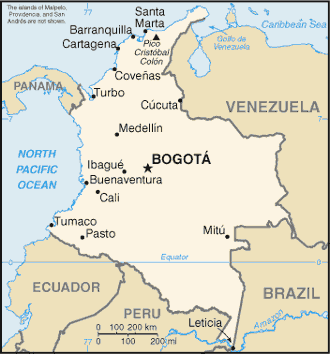Capital: Bogotá
Population: 44.2 million (UN, 2003)
Year of Independence: 1810, from Spain
Type of Government: Republic (“executive branch dominates government structure”)
GNP: $255 billion (2001 est.)
Natural Resources: petroleum, natural gas, coal, iron ore, nickel, gold, copper, emeralds, hydropower
Political Parties: Conservative Party (PSC); Liberal Party (PL); Patriotic Union (UP) is a legal political party formed by Revolutionary Armed Forces of Colombia (FARC) and Colombian Communist Party (PCC); 19 of April Movement (M-19)
note: Colombia has about 60 formally recognized political parties, most of which do not have a presence in either house of Congress
Colombia’s physical landscape is dominated by three Andean mountain chains, volcanoes, undeveloped Eastern lowlands, rich natural resources, and centralized urban populations, while its political landscape is directed by its infamous drug trade and by violent guerrilla groups, as well as paramilitaries. This constant political and social unrest has spread to surrounding countries in limited regions, endangering Colombia’s international relationships along with its economy. Significant resources such as oil, precious metals, coal, and agricultural crops like coffee fuel the illegal drug traffic instead of boosting the economy to the extent they might otherwise. Under presidential rule since the last coup of 1957, Colombia’s government endures extensive corruption and mishandling of funds, and the actions of Revolutionary Armed Forces of Colombia and other guerrilla groups protest these and other conditions through kidnappings and battles for control over coca-producing regions. The newest president, Alvaro Uribe Velez, was an independent candidate and hopes to decrease the control of paramilitaries and guerrillas, a daunting task.



